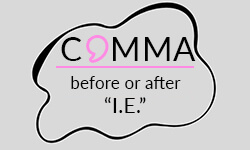
Comma placement can be difficult for many students, especially in academic writing. This is often because they may not be fully aware of the rules and exceptions that apply to the use of commas. In this article, we aim to help clarify one instance where comma placement can become tricky. We provide examples and explain the exceptions to the rules of when to use a comma before or after “i.e.” Furthermore, we offer a practice sheet for students to test their understanding.
When to place a comma before or after “i.e.”
“I.e.” is an abbreviation derived from the Latin phrase “id est,” which translates to “that is” in English. It is used to introduce a clarification, explanation, or expansion of an idea. “I.e.” is used to provide more precise information or to rephrase and clarify a preceding statement. It is commonly employed in writing to ensure that the reader fully understands the specific details or meaning being conveyed.
Comma
Parenthetical clause
No comma
British style guide
Comma rules can vary depending on style guides and the complexity of sentences, which can result in exceptions to comma placement. Consider readability without commas.
Note: It’s easy to remember the meaning of “i.e.” because it can be replaced with “in other words.”
Comma before or after “i.e.”
It is generally recommended to always use a comma before and after “i.e.” as a punctuation convention to signal the introduction of examples that clarify or illustrate the preceding statement.
Parenthetical clause
Use a comma before and after “i.e.” when it is used to introduce a clarification, explanation, or further details. This creates a pause in the sentence to signal that additional information is coming.
No comma before or after “i.e.”
Whether to use a comma after “i.e.” is largely a matter of personal preference, and various different style guides may have their own distinct recommendations. In British English, a comma is typically placed before “i.e.,” but the subsequent comma is often omitted.
British style guide
In British English, some style guides, such as the Oxford Style Manual and The Guardian Style Guide, do not use a comma after “i.e.” in certain cases. The reason for this could be to make the written text look cleaner and more streamlined. Moreover, some argue that omitting the comma can increase readability by avoiding any potential visual clutter.
It is essential to keep in mind that style preferences may vary, and publications or organizations may follow different guidelines. Writers and editors often follow the specific style guide prescribed by the publication they are writing for or the organisation they belong to.
Test yourself!
Practice sheet
In the following, practice sentences for using commas before and/or after “i.e.” are provided. Check the solution in the second tab named “answers.”
- The conference will cover key topics i.e. machine learning and artificial intelligence.
- The team will focus on specific areas i.e. marketing and sales.
- We need to consider various factors i.e. budget, timeline, and resources.
- She enjoys outdoor activities i.e. hiking, biking, and camping.
- The project requires skilled professionals i.e. engineers and designers.
- The software offers several features i.e. data analysis and visualization.
- He has expertise in different programming languages i.e. Python, Java, and C++.
- The museum displays various art styles i.e. impressionism, cubism, and surrealism.
- The company emphasizes core values i.e. integrity, teamwork, and innovation.
- The report highlights key findings i.e. trends, challenges, and opportunities.
- The conference will cover key topics, i.e., machine learning and artificial intelligence.
- The team will focus on specific areas, i.e., marketing and sales.
- We need to consider various factors, i.e., budget, timeline, and resources.
- She enjoys outdoor activities, i.e., hiking, biking, and camping.
- The project requires skilled professionals, i.e., engineers and designers.
- The software offers several features, i.e., data analysis and visualization.
- He has expertise in different programming languages, i.e., Python, Java, and C++.
- The museum displays various art styles, i.e., impressionism, cubism, and surrealism.
- The company emphasizes core values, i.e., integrity, teamwork, and innovation.
- The report highlights key findings, i.e., trends, challenges, and opportunities.
Note: The British style guide allows the omission of the comma after “i.e.” in all the sentences above. The usage depends on your personal preferences.
- ✓ 3D live preview of your individual configuration
- ✓ Free express delivery for every single purchase
- ✓ Top-notch bindings with customised embossing

FAQs
Yes, a comma is typically placed before “i.e.” when it is used to introduce a clarification or explanation in a sentence.
Most British style guides do not recommend using a comma after “i.e.”. However, you do put a comma before “i.e.”. If the American style guide is applied, place commas after and before “i.e.”.
“I.e.” is used correctly when it is employed to introduce a clarification, explanation, or expansion of an idea in a sentence. It is typically preceded by a comma and is used to provide more specific details or rephrase a concept for clarity.
No, a semicolon is not typically placed after “i.e.” It is usually followed by a comma and used to introduce a clarification or explanation in a sentence.
